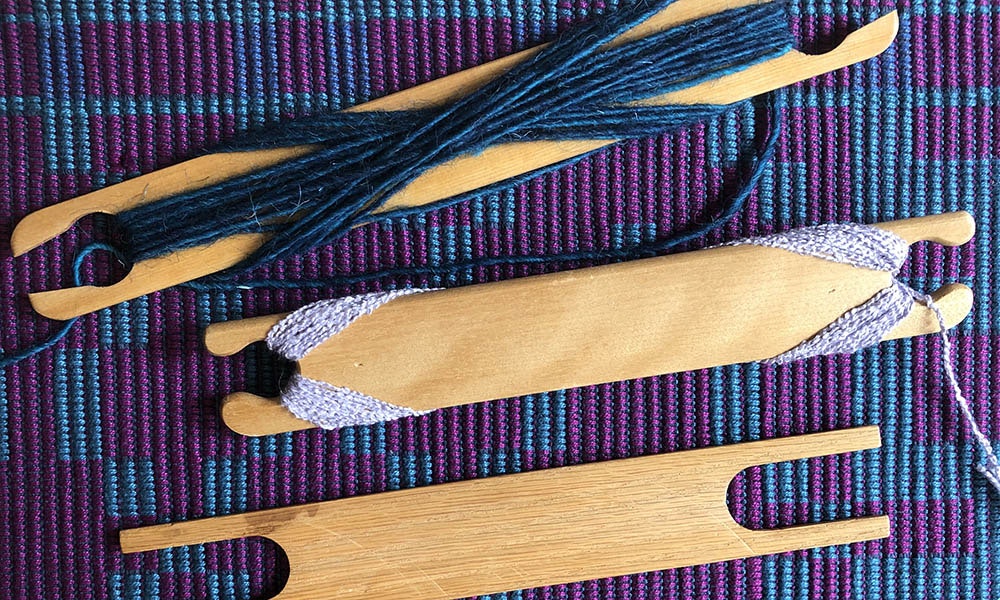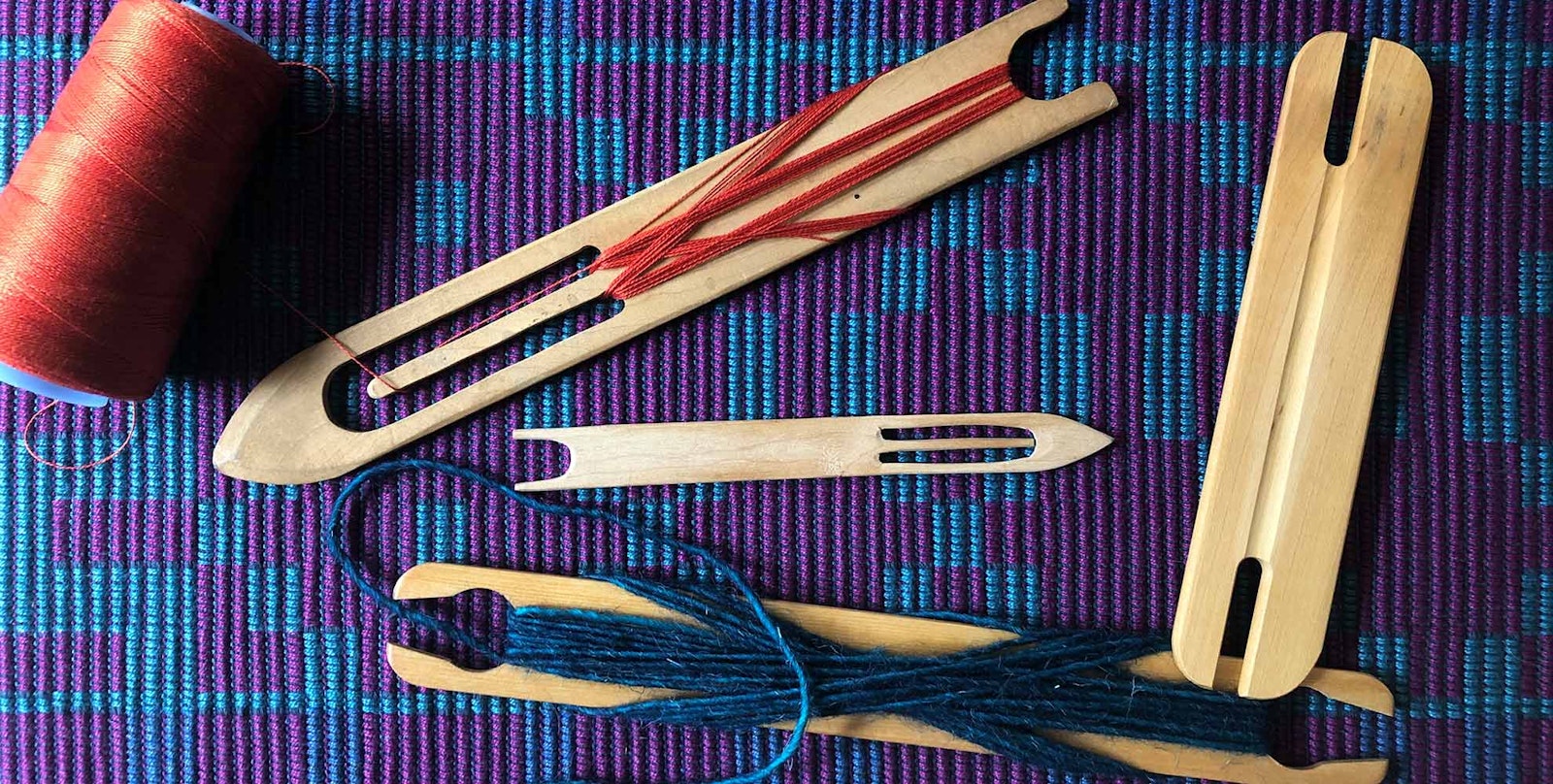I recently asked Liz Moncrief, who knows a lot about weaving equipment, if she would be interested in writing a few posts that would describe the many shuttles available, the types of projects they are best suited for, and how to load them. We tossed around a few ideas, and she came up with a proposal for 4 posts that describe the main types of weaving shuttles. Who knows, there may be more than 4 posts needed, but we'll start there. —Susan
One item that garners a lot of discussion among weavers, both new and seasoned, is the weaving shuttle. There are many makes and models available, and most are tailored to specific types of weaving. With this series, I review the main categories of shuttles and offer tips on how best to load and use them. In this post, I start with the simplest shuttles available; I’ll progress to the more advanced types in future posts.
The simplest weaving shuttle is a flat STICK SHUTTLE. You can pick up a stick shuttle anywhere that weaving supplies are sold, or you can easily carve your own. Stick shuttles are generally used on table looms (including rigid-heddle looms) with narrow sheds. The shuttle doesn’t glide across the warp on a shuttle race but instead is passed from the right to left hand and back again. Sliding the shuttle across the warp causes friction on the warp and is ineffective.
Wind a flat stick shuttle with a figure eight using the arms or notches from the top right to the bottom left. When it starts to get too full, switch to the top left to the bottom right. This will build the bulk of your weft yarn on one side of the stick. If you’re really going for yardage, you can turn the stick over and do the same on the other side, but you risk building a lot of bulk on the shuttle, which may hinder the pass through the shed.

Stick shuttles vary in size and shape, but they all are useful for specific tasks.
Another flat shuttle is the BELT OR BAND SHUTTLE, which is usually no more than 6–10 inches long and made for use on an inkle or band loom. Most belt shuttles have a knife edge on one side, designed for packing in the weft, and a recessed center trough to enable it to carry more weft. Because of this recessed area, it is best to simply wind the weft yarn around from front to back and to build up the yarn on both sides. Despite its small size, a belt or band shuttle can hold a good amount of weft.

Band shuttles often have a recessed middle to hold more weft and a knife edge for packing in weft on the loom.
The NETTING SHUTTLE has been used for centuries in making and repairing fishing nets, but weavers find it useful for hand-manipulation techniques such as Spanish medallions or Brook’s Bouquet designs. It is sleek and passes easily between warp threads. Netting shuttles can also be used in place of butterflies in tapestry weaving and for adding short lengths of weft of a special color or designer yarn.
Next in my line-up is the RAG SHUTTLE, which is designed to hold a flat strip of fabric for rag rugs or other similar projects. This shuttle is usually pretty beefy and requires the large shed found on counterbalance and countermarch looms. Wind your rag strips around and around the shuttle keeping them flat. Although the rag strips will be compressed, starting out with a flat strip makes it easier to maintain the colored fabric surface in the finished piece.

Wind your rag shuttles with the rags flat for best results.
How Much to Wind?
Many weavers want to avoid loading more weft on a shuttle than they need in their woven piece. On the other hand, you may want to know whether you have enough weft to complete a piece without having an unnecessary join. Here’s my easy method for figuring out how much weft to wind. It’s easy to do and fairly accurate.
- Before starting to weave, measure a test length of weft yarn that is 10 yards long.
- Wind the 10 yards on your shuttle and count the number of full winds as you do so. (Let’s say your 10 yards equals 20 full winds on your shuttle.)
- Weave your piece until you run out of weft and measure how many inches you’ve woven. (For purposes of this example, I’ll say that you wove 5 inches before running out of weft. 20 winds = 5 inches, or 4 winds = 1 inch.)
- Based on the number of inches you want to weave, calculate how many winds you need to make for the entire project. (If you want to weave 60 inches, and 4 full winds gave you 1 inch of cloth, you will need 240 full winds on your shuttle.)
- If the number of winds needed is excessive, such as in #4 above, simply wind an amount that’s comfortable on each shuttle load and wait until you are close to the end. Then simply figure out what you need for the last section of your weaving using the number of winds needed for each inch that you figured out in step 3.
In my next post in this series, I’ll discuss rug and ski shuttles, the best methods for winding them, and the type of weaving that you use them for. After that, I’ll look at boats, double-boats, open- and closed-bottom, and end-feed shuttles.
In future posts, I’ll also cover finish and maintenance and what you can do to make your shuttles the most efficient for your weaving. There are so many considerations, especially when you realize that you may be passing this shuttle many thousands of times in a woven piece. So let’s find the proper tool for you.
Originally published August 28, 2020; updated April 15, 2024.

